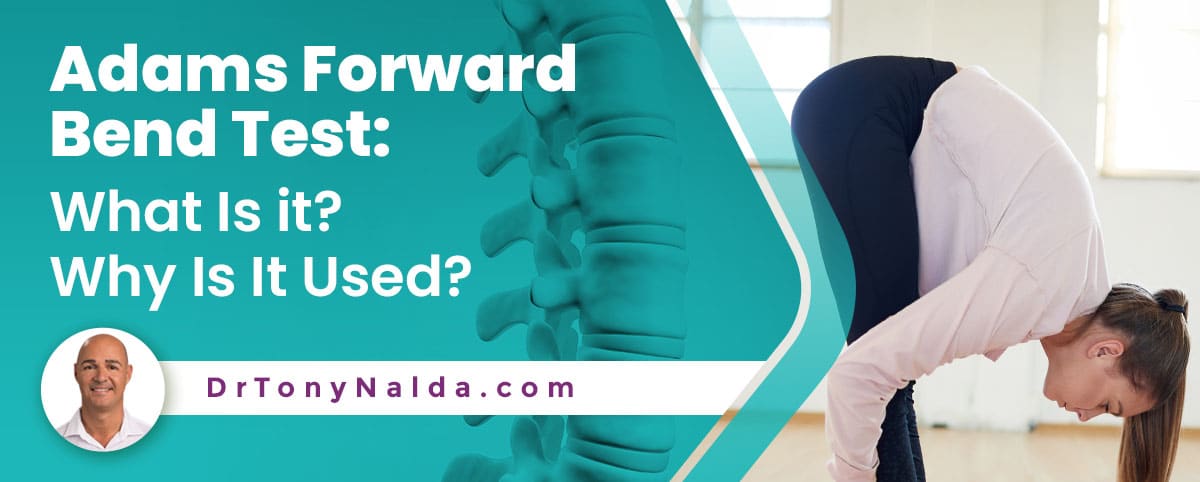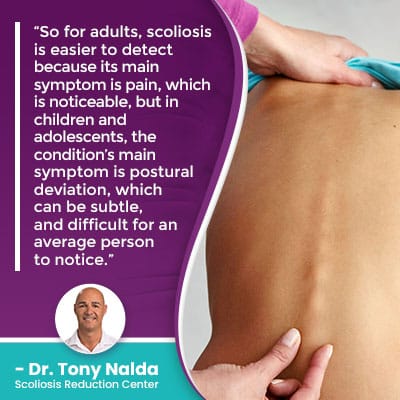Adams Forward Bend Test: What Is it? Why Is It Used?

Early detection is particularly beneficial with progressive conditions like scoliosis; it’s in their nature to worsen over time, especially if left untreated, or not treated proactively. When in a forward-bend position, the spine is most visible, and an unnatural spinal curve, as well as the postural changes it causes, are easier to detect.
Part of screening for scoliosis includes an Adam’s forward bend test that involves having the spine examined while in a forward-bend position. In this position, the spine, and any related asymmetries, are the most noticeable. If the test shows condition indicators, further testing is warranted.
While there are no treatment guarantees, early detection, when coupled with proactive treatment, can increase chances of treatment success, so let’s start with the benefits of early detection.
Table of Contents
Early Detection and Scoliosis
Scoliosis is a complex condition to treat. Not only does it range widely in severity and has multiple types a person can develop, it is also a progressive condition.
Before we get to the challenge of the condition’s progressive nature, let’s first discuss how a diagnosis of scoliosis is reached.
There are a number of spinal conditions that involve a loss of its unhealthy curves, but scoliosis has some unique parameters that have to be met to be considered a true scoliosis.
First of all, scoliosis is the development of an unnatural sideways spinal curve, but in addition to bending unnaturally to the side, a scoliotic spine also rotates (twists), making it a 3-dimensional condition.
The unnatural spinal curve also has to be of a minimum size: Cobb angle measurement of at least 10 degrees.
The spine’s natural and healthy curves are key to its optimal health and function; they make it more flexible, stronger, and better able to absorb/distribute mechanical stress incurred during activity.
When the spine loses one or more of its natural and healthy curves, its biomechanics are disrupted, and a lot of uneven forces are introduced to the spine and body.
If left untreated, those uneven forces increase over time, as do their effects, and this is due to the condition’s progressive nature.
Scoliosis is Progressive
Scoliosis being progressive means that it’s virtually guaranteed to get worse over time; only proactive treatment can work towards counteracting the condition’s progressive nature.
If scoliosis progresses, the unnatural spinal curve is increasing in size, with the vertebrae (bones of the spine) becoming increasingly tilted and less aligned with the rest of the spine.
As scoliosis progresses, the condition’s uneven forces that disrupt the body’s overall symmetry are also increasing, and the condition is getting more complex to treat.
Scoliosis is simplest to treat early in its progressive line, which is also the condition’s severity scale:
- Mild scoliosis: Cobb angle measurement of between 10 and 25 degrees
- Moderate scoliosis: Cobb angle measurement of between 25 and 40 degrees
- Severe scoliosis: Cobb angle measurement of 40+ degrees
- Very-severe scoliosis: Cobb angle measurement of 80+ degrees
The higher a patient’s Cobb angle, the more severe the condition, the more noticeable its symptoms are likely to be, and the larger a scoliotic curve, the more likely continued progression is.
Scoliosis is simplest to treat when it’s at its mildest, while the curve is small, and before the body has adjusted to the unnatural spinal curve’s presence.
In addition, the spine’s rigidity increases with progression, making it less responsive to treatment: another benefit of proactive treatment started early.
So for a parent, and/or caregiver, is concerned about scoliosis in a child, what is the screening process?
Scoliosis Screening
Scoliosis is a highly-prevalent spinal condition; the Scoliosis Research Society has current estimates at between 6 and 9 million people currently living with scoliosis in the United States alone, and scoliosis is the leading spinal condition amongst school-aged children.
There was a time when mandatory scoliosis screening was performed by school nurses, and this is because adolescent idiopathic scoliosis (AIS) is the most prevalent form, diagnosed between the ages of 10 and 18.
Now, the idiopathic designation means we don’t fully understand its initial onset, but we most certainly know how to treat it effectively, and we do understand its progressive trigger: growth and development.
Children and adolescents who have not yet reached skeletal maturity are at risk for rapid-phase progression because they have so much growth yet to go through.
So for children and adolescents, early detection is particularly beneficial, and this involves a screening exam performed by a professional.
What is an Adam’s Forward Bend Test?
If a child is showing signs of scoliosis, they should be taken in for a screening exam.
When a parent and/or caregiver comes in with concerns, the first step is to perform a comprehensive physical examination that includes taking the patient’s family history, with a focus on spinal conditions like scoliosis.
I also observe how the patient holds themselves (posture) and walks; I can tell a lot about a patient by how they walk.
Then I perform what’s called an Adam’s forward bend test, and this involves having the patient stand in front of me and bend forward at the waist as if trying to touch their toes, at a 90-degree angle, with the arms hanging down at the sides.
I stand behind the patient and examine the spine because in this position, any related asymmetries, and sometimes the curvature itself, is visible to the naked eye.
In addition, as scoliosis can disrupt the body’s overall symmetry, oftentimes, the earliest signs of adolescent idiopathic scoliosis are uneven shoulders and hips, and the development of a rib arch, which are also highly visible in this position.
When paired with a Scoliometer, the results of an Adam’s test become more specific.
What’s a Scoliometer?
When paired with a Scoliometer, the results of an Adam’s forward bend test can also indicate the angle of trunk rotation (ATR).
A Scoliometer looks like a cross between a ruler and a level, with a notched out section at its center to be placed over the spine, and the internal bubble aligns with the measurement of trunk asymmetry.
The Scoliometer’s reading indicates the degree of tilt in the spinal section with the unnatural curve.
 Although it’s not a diagnostic tool, the Adam’s test is an effective screening exam that indicates whether or not a person should be further tested.
Although it’s not a diagnostic tool, the Adam’s test is an effective screening exam that indicates whether or not a person should be further tested.
If the bubble aligns with 7 degrees, this equates to approximately a 20-degree measurement via X-ray.
When it comes to AIS, screening exams, and knowing the condition’s subtle early indicators to look for, can be extremely beneficial in terms of treatment, and also because early detection isn’t always easy to achieve.
Why is Early Detection Difficult?
When it comes to AIS, the most prevalent type of scoliosis, while it might seem surprising that an unnatural spinal curve wouldn’t be obvious, this is often the case.
Particularly in mild forms, scoliosis isn’t known to cause functional deficits, and the main reason behind the challenge of early detection is that scoliosis in children and adolescents isn’t generally painful, and while pain is unpleasant, it does serve a vital purpose: it tells us something is wrong with the body.
In children and adolescents who are still growing, their spines are experiencing a constant lengthening motion, and this counteracts the compressive force of the unnatural spinal curve; compression of the spine and its surrounding muscles and nerves is the main cause of condition-related pain.
 So for adults, scoliosis is easier to detect because its main symptom is pain, which is noticeable, but in children and adolescents, the condition’s main symptom is postural deviation, which can be subtle, and difficult for an average person to notice.
So for adults, scoliosis is easier to detect because its main symptom is pain, which is noticeable, but in children and adolescents, the condition’s main symptom is postural deviation, which can be subtle, and difficult for an average person to notice.
The challenge of early detection, and how beneficial it can be, is why scoliosis screening is so important.
Conclusion
So an Adam’s forward bend test, when combined with a Scoliometer, is a reliable screening exam that looks for scoliosis indicators that warrant the need for further testing.
If an Adam’s test has shown a number of condition indicators to be present, an X-ray is performed that helps me see exactly what’s happening in and around the spine, as well as measuring the patient’s Cobb angle to help shape the design of effective treatment plans.
So if an X-ray shows an unnatural sideways spinal curve, with rotation, and a Cobb angle of at least 10 degrees, a diagnosis of scoliosis can be given.
At the Scoliosis Reduction Center, I use a modern conservative treatment approach to treat scoliosis proactively; starting treatment as close to the time of diagnosis as possible is the best way to work towards preventing further progression.
While there are no treatment guarantees, by combining multiple different condition-specific treatment disciplines such as chiropractic care, in-office therapy, corrective bracing, and rehabilitation, scoliotic curves can be reduced on a structural level, while core strength is increased to optimally support the spine.
But before treatment can even start, a diagnosis has to be reached, and this is facilitated by early detection, and its many benefits in terms of treatment success.
Dr. Tony Nalda
DOCTOR OF CHIROPRACTIC
After receiving an undergraduate degree in psychology and his Doctorate of Chiropractic from Life University, Dr. Nalda settled in Celebration, Florida and proceeded to build one of Central Florida’s most successful chiropractic clinics.
His experience with patients suffering from scoliosis, and the confusion and frustration they faced, led him to seek a specialty in scoliosis care. In 2006 he completed his Intensive Care Certification from CLEAR Institute, a leading scoliosis educational and certification center.
About Dr. Tony Nalda
 Ready to explore scoliosis treatment? Contact Us Now
Ready to explore scoliosis treatment? Contact Us Now





